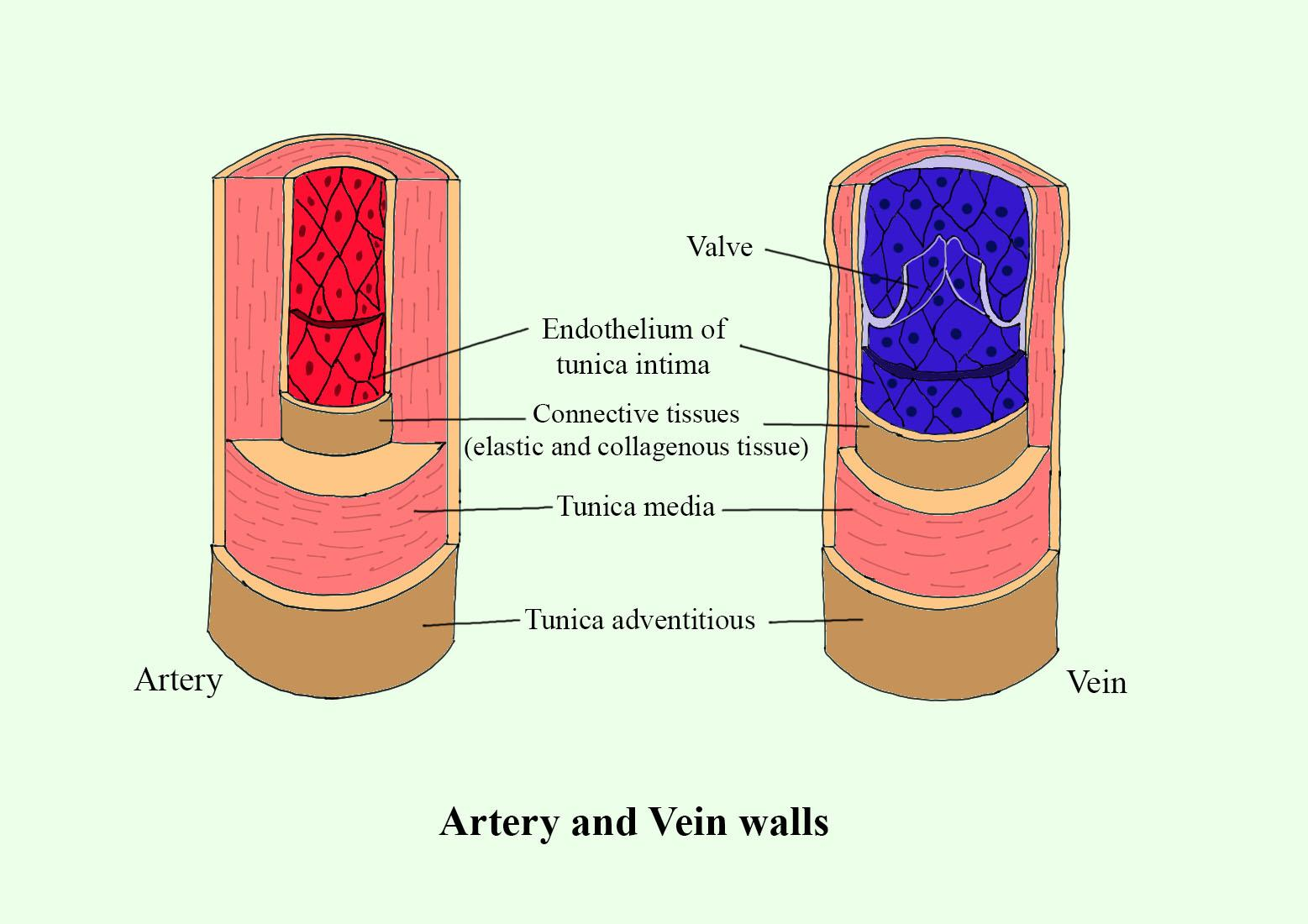
With the help of labeled diagrams describe the structure of an artery, a vein, and a capillary. State how each of these is adapted for its functions.
Answer
556.8k+ views
Hint: Arteries are blood vessels that take blood away from the heart whereas veins are the blood vessels that bring blood back towards the heart. Capillaries are fine blood vessels with a thin wall that facilitates the diffusion of substances across the tissues of the body and the body.
Complete answer:
The structure of blood vessels: The walls of arteries and veins are made up of three layers consisting of an inner lining of squamous epithelium, a middle layer of smooth muscles and elastic fibers known as tunica intima, and an external layer made up of collagen fibers known as tunica externa.
Arteries: Arteries and arterioles have thicker walls because of the high-pressure blood flowing in them as they receive the blood directly from the heart. The thicker walls and narrow diameters give the appearance of a rounded wall during a cross-sectional view.
Veins: The pressure of the blood when it reaches veins has diminished significantly as it flowed throughout the body in arteries and capillaries. Thus veins have to withstand comparatively low pressure and as a result, have a thin wall and a larger lumen. The tunica media is thicker in veins compared to the arteries. Veins also have valves in order to prevent the backflow of the blood.
Capillaries: The major function of the capillary is to exchange nutrients, waste, and oxygen with the tissues and thus have a thin wall to allow the exchange of materials across it. Capillaries are known as the smallest blood vessels as they are formed by the continued division of arteries.

Note: The cells of the walls of arteries and veins are also supplied with a network of blood vessels known as vasa vasorum which literally means “vessels of the vessel”.
Blood flows inside the body in two distinct circuits known as the systemic circulation and the pulmonary circulation.
In pulmonary circulation deoxygenated blood is pumped to the lungs to make it oxygenated and in systemic circulation oxygenated blood is supplied to the tissues of the body.
Complete answer:
The structure of blood vessels: The walls of arteries and veins are made up of three layers consisting of an inner lining of squamous epithelium, a middle layer of smooth muscles and elastic fibers known as tunica intima, and an external layer made up of collagen fibers known as tunica externa.
Arteries: Arteries and arterioles have thicker walls because of the high-pressure blood flowing in them as they receive the blood directly from the heart. The thicker walls and narrow diameters give the appearance of a rounded wall during a cross-sectional view.
Veins: The pressure of the blood when it reaches veins has diminished significantly as it flowed throughout the body in arteries and capillaries. Thus veins have to withstand comparatively low pressure and as a result, have a thin wall and a larger lumen. The tunica media is thicker in veins compared to the arteries. Veins also have valves in order to prevent the backflow of the blood.
Capillaries: The major function of the capillary is to exchange nutrients, waste, and oxygen with the tissues and thus have a thin wall to allow the exchange of materials across it. Capillaries are known as the smallest blood vessels as they are formed by the continued division of arteries.

Note: The cells of the walls of arteries and veins are also supplied with a network of blood vessels known as vasa vasorum which literally means “vessels of the vessel”.
Blood flows inside the body in two distinct circuits known as the systemic circulation and the pulmonary circulation.
In pulmonary circulation deoxygenated blood is pumped to the lungs to make it oxygenated and in systemic circulation oxygenated blood is supplied to the tissues of the body.
Recently Updated Pages
Two men on either side of the cliff 90m height observe class 10 maths CBSE

Cutting of the Chinese melon means A The business and class 10 social science CBSE

Show an aquatic food chain using the following organisms class 10 biology CBSE

How is gypsum formed class 10 chemistry CBSE

If the line 3x + 4y 24 0 intersects the xaxis at t-class-10-maths-CBSE

Sugar present in DNA is A Heptose B Hexone C Tetrose class 10 biology CBSE

Trending doubts
Why is there a time difference of about 5 hours between class 10 social science CBSE

What is the median of the first 10 natural numbers class 10 maths CBSE

The Equation xxx + 2 is Satisfied when x is Equal to Class 10 Maths

Write a letter to the principal requesting him to grant class 10 english CBSE

What are luminous and Non luminous objects class 10 physics CBSE

A Paragraph on Pollution in about 100-150 Words




